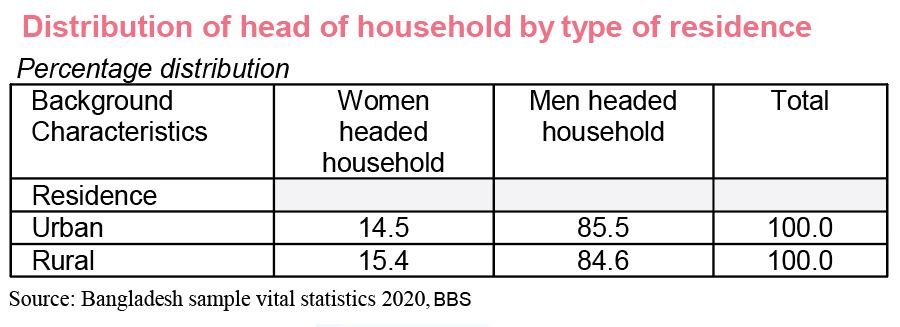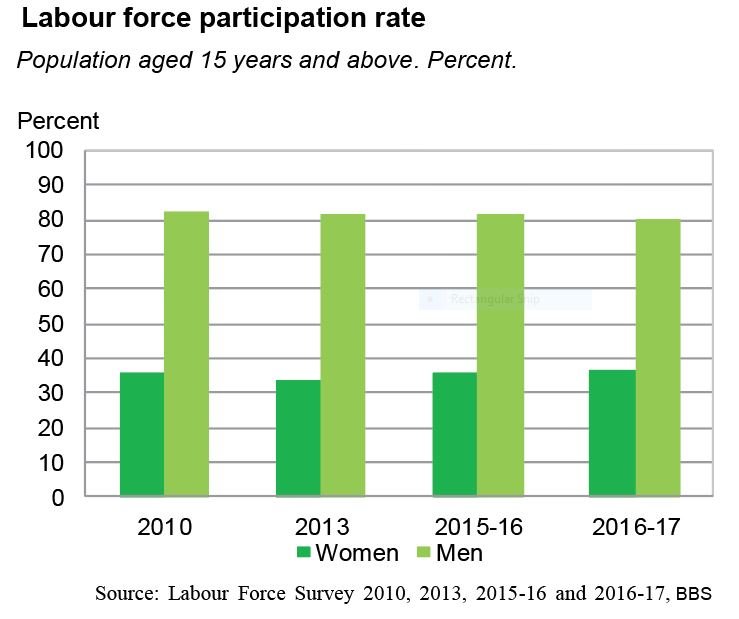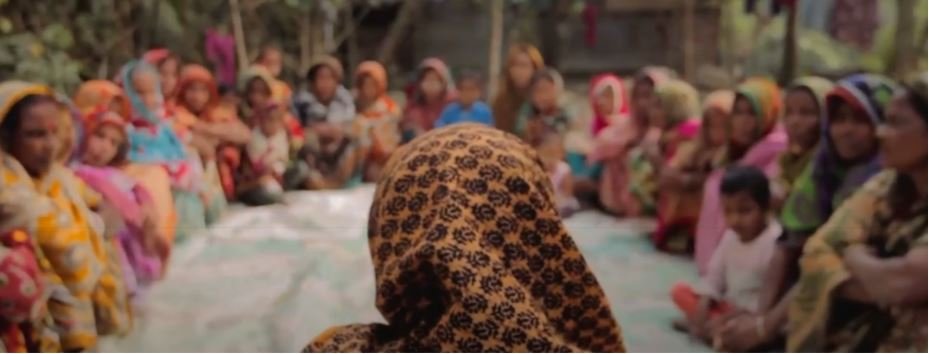Bangladesh has made significant progress in improving the lives of women, with lower maternal mortality rates, declining fertility rates, and greater gender parity in school enrolment. The country has been globally recognized for its successful efforts to promote women’s empowerment, particularly through its commitment to achieving the Sustainable Development Goals (SDGs).
You can also read: How female representation in politics is changing?
However, there is still room for improvement in terms of women’s labour force participation. While women in Bangladesh have made significant strides in various areas, they remain underrepresented in the formal workforce, particularly in higher-paying jobs. Therefore, there is a need to continue efforts to increase women’s labour force participation and create more opportunities for them to participate in the country’s economic growth.
IMPROVEMENTS IN WOMEN’S LIVES
Bangladesh has made remarkable strides in enhancing the lives of women, with significant improvements in maternal health and a decline in fertility rates. According to the World Health Organization (WHO), maternal mortality rates have fallen from 322 deaths per 100,000 live births in 2001 to 196 deaths in 2016. Additionally, the fertility rate has decreased from 6.9 children per woman in 1971 to 2.1 in 2018, according to the United Nations Population Fund (UNFPA). The country has also made

significant progress in promoting girls’ education, with gender parity achieved in primary and secondary school enrolment, and more girls attending secondary school than boys. Furthermore, more than 30 million women in Bangladesh are clients of microcredit organisations, which have helped to improve their economic and social status. These advancements have significantly contributed to the improved lives of women in Bangladesh, and the country’s efforts to empower women have been recognised globally.
Furthermore, Bangladesh has the highest percentage of women in the workforce in South Asia, with around 35 percent of women participating in the labour force. In recent years, Bangladesh has shown a positive trend in women’s participation in the workforce. According to the World Bank, the percentage of women in the labour force has increased from 26.6 percent in 2010 to 36.2 percent in 2020.
However, according to The Global Economy, female labour force participation in Bangladesh was 34.87 percent in 2021. The government has taken various initiatives to promote women’s entrepreneurship and economic empowerment, such as providing training, credit, and marketing support. Additionally, women’s political representation has improved, with women holding 21 percent of seats in parliament.
However, more needs to be done to increase women’s participation in higher-paying sectors and reduce the gender wage gap. Despite these challenges, Bangladesh has demonstrated a commitment to advancing women’s rights and empowerment, and the progress made so far is a positive sign for the future.

WOMEN’S PARTICIPATION: WHAT STATS SHOW?
In Bangladesh, women’s participation in the workforce remains constrained to limited, low-paying sectors, with significant barriers to entry and limited opportunities for advancement. Although the number of women involved in the ready-made garment sector is increasing, only 3 million Bangladeshi women are employed in this industry. There are also large finance gaps that women face despite several government initiatives. Women’s employment is often concentrated in low-paying and insecure sectors, such as agriculture, domestic work, and informal jobs, with little job security or benefits. Gender-biased social norms keep most women trapped in disadvantaged situations, and they suffer from high workload and unpaid labour, lack of decision-making power in the household and society, and subordination.
According to a report by the International Labour Organization (ILO), the female labour force participation rate in Bangladesh was only 36.4 percent in 2020, compared to 84.0 percent for men. Although the number of women employed in the ready-made garment sector has increased in recent years, with women now comprising around 60 percent of the sector’s workforce, there are still significant challenges. Many women working in the garment industry face poor working conditions, low wages, and long working hours. Furthermore, the Covid pandemic has had a significant impact on the industry, with many workers losing their jobs or experiencing reduced hours and wages. Despite several government initiatives to support women’s economic empowerment, there are still large finance gaps that women face in accessing credit and other financial services.
A study by the World Bank found that women in Bangladesh are 7 percent less likely than men to have a bank account, and only 4.4 percent of women have taken out a loan from a formal financial institution. Experts point to gender-biased social norms as a major factor holding women back from achieving economic empowerment. Women in Bangladesh are often expected to prioritize their domestic duties and caregiving responsibilities, leading to high workloads and unpaid labour.

Additionally, traditional gender roles and patriarchal attitudes can limit women’s decision-making power in the household and society, making it more difficult for them to pursue education and career opportunities.
According to Naila Kabeer, a renowned British-Bangladeshi gender and development expert, a professor of Gender and Development at the London School of Economics, “In Bangladesh, the challenge is to transform a society where gender roles and social norms are deeply entrenched, and where women’s economic empowerment is often seen as threatening to male authority and control.” She suggests that addressing these social norms and attitudes is critical to improving women’s participation in the workforce and advancing their economic empowerment. Kabeer emphasizes the importance of creating policies and programs that challenge traditional gender roles and promote women’s decision-making power and agency.
Despite these challenges, there have been some positive developments. The government has launched several initiatives to support women’s economic empowerment, including the National Women Development Policy 2011 and the National Strategy for Accelerated Poverty Reduction. Moreover, a recent report by the World Bank highlights the potential benefits of increasing women’s labour force participation in Bangladesh, including increased economic growth and reduced poverty rates.

FEMALE ENTREPRENEURSHIP IN RURAL BANGLADESH
Only 7.5 percent of 5.8 million rural enterprises in Bangladesh are owned by women. Moreover, these enterprises are concentrated in sectors such as tailoring, textiles, and bamboo and cane products, which are not associated with high-growth opportunities. Women-owned enterprises in rural Bangladesh have 0.84 paid full-time employees, while men-owned enterprises have 1.55, almost double. 64 percent of women-owned enterprises do not have any full-time employees at all, indicating that these are small personal ventures rather than organized businesses. Despite the low percentage of female-owned rural enterprises, there has been some progress in recent years.


According to the World Bank, the number of women-owned businesses in Bangladesh increased from 5.4 percent in 2013 to 8.5 percent in 2020. However, these businesses are still largely informal and lack access to finance, technology, and markets. This hinders their growth potential and limits their ability to create employment opportunities. In terms of access to finance, women entrepreneurs face significant challenges, with only 13 percent of women in rural areas reporting access to formal credit in 2020, compared to 27 percent of men.
Additionally, women face significant cultural and social barriers, such as limited mobility and social norms that restrict their ability to interact with men outside their family or community. Despite these challenges, there are successful examples of women entrepreneurs in rural Bangladesh, who founded a successful business and are now a role model for other women in her community.
IS WOMEN EMPOWERMENT IN BANGLADESH RHETORIC OR REALITY?
Despite impressive achievements in schooling and microfinance for women, Bangladesh still has low female labour force participation and a virtual absence of women entrepreneurs. While social stigma against women is prevalent in rural areas, a spatial analysis of female-owned enterprises reveals an interesting trend. Among the five districts with the highest proportion of female-owned enterprises, two are from the Chittagong Hill Tracts (CHT) region, indicating that ethnic and linguistic minorities, who are concentrated in this region, maybe more receptive to women’s entrepreneurship than others. Furthermore, there have been some recent efforts to address the gender gap in entrepreneurship and increase women’s access to finance and resources.
For example, the government has launched initiatives like the Women Entrepreneurship Fund, which provides low-interest loans to women entrepreneurs, and the Women’s Digital Centre, which offers training and support for women to develop digital skills. The private sector has also started to take notice, with companies like Grameenphone’s partnering with women entrepreneurs to provide training and mentorship. While there is still a long way to go, these initiatives show that there is room for improvement and that Bangladesh is taking steps towards making women’s empowerment a reality. In conclusion, Bangladesh has made significant progress in improving the lives of women and girls, but there are still significant challenges to be overcome. Pervasive sexual violence and gender-based violence continue to hinder women’s empowerment, and child marriage rates are the highest in South Asia. Women’s participation in the workforce is also constrained to limited, low-paying sectors.

However, the success story of Bangladesh in advancing opportunities for women is well known, and the country’s economic transformation has largely been driven by social changes, initiated by women empowerment. With a multi-sectoral and interdisciplinary view on structural transformation that includes institutions that mediate social and economic policies, Bangladesh can continue to advance women’s rights and gender equality. It will require a sustained commitment from the government, civil society, and the private sector to address the root causes of gender inequality, including discrimination, poverty, and lack of access to education and healthcare. Empowering women and girls is not just a matter of human rights and social justice; it is also an essential ingredient for sustainable economic growth and development. By investing in women’s education, health, and economic empowerment, Bangladesh can build a more prosperous and equitable society for all its citizens.


